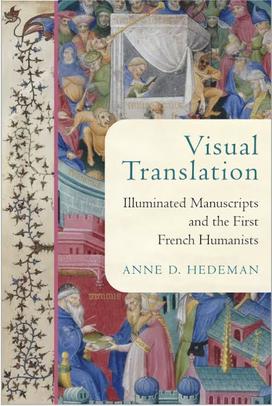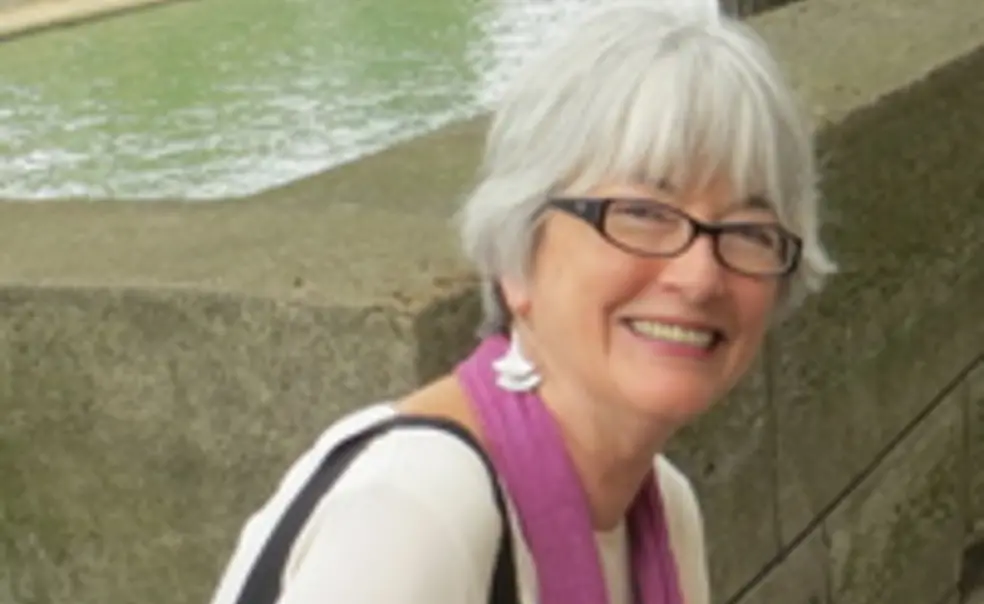Anne D. Hedeman ’74 Deepens Our Understanding of Medieval Imagery
The book: Focusing on texts from the first half of the 15th century, Anne D. Hedeman ’74 displays her expertise in analyzing medieval manuscripts in this latest work, Visual Translation: Illuminated Manuscripts and the First French Humanists (Notre Dame Press.) The book explores how visual translation works — or the role text and images play in an audience’s understanding of the work as well as the message the creators intended to get across — by studying manuscripts of both Latin and French by various writers including Statius and Bocaccio. With more than 180 color images, this scholarly work adds to our understanding in the fields of French humanism, textual translation, and the reception of the classical tradition during this time period.

The author: Anne D. Hedeman ’74 is a professor in the art history department at the University of Kansas. Her research examines the relationships between text and image in vernacular late medieval French manuscripts. She is the author of multiple books including Translating the Past and Of Counselors and Kings. Hedeman earned her degree from Princeton in art and archaeology and earned advanced degrees from Johns Hopkins University.
Excerpt:
Chapter 1
Noble Leisure and French Humanism
Beginning in the fourteenth century during the reigns of the Valois kings, French humanism and translation were associated, and they flourished with the active support of King Charles V, who reigned from 1364 to 1380. At its inception, French humanism was enriched by contacts made by its practitioners in Avignon with Petrarch and the papal chancellery. The connections that scholars made in Italy and deepened through personal correspondence and participation in diplomatic missions continued to influence the graduates and students of the Collège de Navarre in Paris who filled the royal chancellery during the early fifteenth century. Scholars such as Gilbert Ouy, Ezio Ornato, and Carla Bozzolo describe French humanists of the early fifteenth century as motivated by a desire to rival contemporary Italian authors in written expression (which they suggested often manifested a kind of French nationalism) and to collect and study manuscripts of the classics, thus contributing to a French revival of the antique past that often presented it in the image of the French present.
The network of humanists in Paris was a close-knit community that included graduates of the Collège de Navarre, such as Jean de Montreuil, Nicolas de Clamanges, Jean Gerson, and Jean Courtecuisse, as well as notaries and secretaries with different backgrounds such as Gontier Col, Laurent de Premierfait, and Jean Lebègue. They had diverse relations to each other and to members of the nobility. For instance, Jean de Montreuil, Col, Laurent de Premierfait, and Lebègue were royal and ducal notaries. Jean de Montreuil and Gontier Col were also members of the Cour amoureuse, a literary society, founded in 1401 by Dukes Louis of Bourbon and Philip the Bold of Burgundy and headed by King Charles VI, that brought together a cross section of nobility, clerics, and bourgeoisie. They participated actively, along with Pierre Col, Jean Gerson, and Christine de Pizan, in the literary debate surrounding the Roman de la Rose, known in part through dossiers given to Queen Isabeau of Bavaria and Duke John of Berry, among others. Manuscripts annotated by Gontier Col and Jean Lebègue attest that they were avid fans of Laurent de Premierfait. The surviving manuscripts of Jean de Montreuil’s letter collection, also annotated by Lebègue, reveal Jean’s classical knowledge. He peppers his letters with classical references to such authors as Cicero, Virgil, Sallust, Terence, Valerius Maximus, Seneca, Horace, and others. Even more important, Jean de Montreuil’s letters offer insight into the relationships between Col, Laurent de Premierfait, Jean de Montreuil, and other humanists.
Ornato’s analysis of the letter collections shows how Jean de Montreuil was part
of a community that read and discussed classical texts. His letters describe how he obtained books from contacts in Italy and shared them and other manuscripts with colleagues. For instance, in his correspondence with Gontier Col (letter 38), Jean de Montreuil describes a dream in which Terence appeared and told Jean to study his comedies, as Col and Pierre Mahac were doing. Jean also writes Col (letter 120) in 1400 or 1401 to tell him that he had read the Roman de la Rose at Col’s suggestion and loved it. He writes an unknown correspondent (letter 90), to ask to borrow a Latin copy of Augustine’s City of God.
Sometime between 1401 and 1403 Jean de Montreuil wrote a particularly rich series of letters involving rare texts procured from Italy. The first (letter 125) was a letter of introduction sent with Guillaume de Tigonville to a scholarly Italian friend, Jacopo, in which Jean asked what Jacopo had accomplished in the monastery of Cluny and reminded him to transcribe a manuscript of Plautus and to procure a manuscript of Cicero in Bologna. Shortly thereafter (letter 126) Jean thanked Jacopo for sending him the copy of Plautus. In a third letter (letter 157) Jean observed that one of his unknown correspondent’s copyists had just transcribed a manuscript of Livy owned by Jean. Further, he informed that person that he had received rare works from Italy that were unavailable in France, even in a college; these included Cato’s Censorinus, Varro’s De Agricultura, Vitruvius’s De Architectura, and Plautus. Jean offered to make them available to copy. Because Jean ended his letter by asking the addressee to help speed payment of two hundred francs reserved for him by the Duke of Berry, Ornato speculated that this letter may have gone to Martin Gouge, who had classical interests and was the duke’s treasurer and counselor.
François Avril suggested that two Latin manuscripts painted by Virgil Master lluminators around 1405 may be copies made after those mentioned in Jean de Montreuil’s correspondence because they contain several of the rare texts that Jean procured. One combines Vitruvius’s De Architectura, Cato’s De Rustica, and Varro’s Res Rustica (BML Plut. 30.10) and the second contains Plautus’s Comedies (BnF Ms. lat. 7890). Marie-Hélène Tesnière speculated that Jean de Montreuil could equally well have addressed this offer of access to Jacques Courau, treasurer and maître d’hotel to Duke John of Berry, rather than to Martin Gouge. Courau had given a French translation of Valerius Maximus painted by Virgil Master illuminators (BnF Ms. fr. 282) to John of Berry in January 1402. He also owned a Latin manuscript of Virgil’s works transcribed by Pierre de l’Ormel in 1403 (BML Med. Palat. 69) that also was painted by Virgil Master illuminators. Since the same scribe and artists that produced Courau’s Virgil manuscript wrote and decorated Plautus’s Comedies (BnF Ms. lat. 7890), Tesnière suggests that Courau may have been the scholar whom Jean de Montreuil addressed.
While we will never know with certainty the identity of Jean de Montreuil’s noble French reader with interest in classical texts, the precious survival of his letters gives insight into the moment in the early fifteenth century when early French humanists began to promote the classical heritage more broadly to the nobility and the powerful, perhaps in order to counter their ignorance or apathy. In the same letter that had offered the noble Frenchman access to rare classical texts, Jean de Montreuil expressed a wish that other nobles had been as interested as his correspondent in Livy and the other historiographers and authors because then a great portion of Livy and the works of other learned and venerable writers would not be lost. He wrote that talented literate men leaned toward pursuing active and earthly things in such a way that they scorn and reject contemplative things, which Virgil calls “noble leisure,” with the result that modern men had no passion to pursue books from antiquity. Jean referred at the end of the letter to his correspondent’s shared pleasure in reading works that were among the oldest in Latin literature.
Two among the group of humanists in early fifteenth-century Paris—Laurent de Premierfait and Jean Lebègue—were deeply involved in the production of illuminated manuscripts designed to expand the nobility’s cultural exposure to both Latin classics and contemporary Italian literature, thereby combating the phenomenon that Jean de Montreuil described. They are ideal candidates for exploring the complex relationship between the culture of humanist members of the French chancellery and manuscript illumination at the moment when classical texts were being transcribed and painted with an eye toward capturing the attention of new readers.
From Visual Translation: Illuminated Manuscripts and the First French Humanists by Anne D. Hedeman. © 2022 by University of Notre Dame Press. Reprinted by permission of the publisher.
Review:
“Visual Translation will give scholars across the board not only a new understanding of the place of French humanists in the shaping and accessibility of manuscripts whose creation they oversaw but also insight into the complex and integral role that they played in formulating the programs of illumination that would go on to define these texts for generations.” — Elizabeth Morrison, editor of Book of Beasts












No responses yet